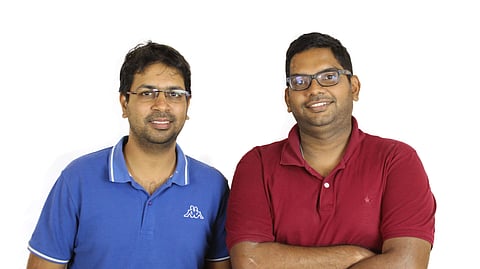

When I say 'ashram', I can bet that most of you readers are thinking of a calm spiritual place where people go to find inner peace or learn yoga or Ayurveda. But could you ever think of an ashram where you can do experiments and learn concepts of Science? Yes, you heard that right - a Science Ashram. And they really exist in cities like Bengaluru and Mysuru! This Science Ashram helps students learn Science in a fun way. Surprisingly, while you would expect this to be the brainchild of ardent senior scientists who have dedicated their life to the subject, it was actually founded by two engineers who wanted to change the way children are taught the 'dreaded' subject at school. In 2014, Dhruva Rao and Rohan Abhijit came together and started the first Science Ashram in Mysuru. Now, they have spread to different cities including Bengaluru, Hyderabad and Mumbai.
Narrating what led them to start Science Ashram, Dhruva says, "Like most youngsters of our generation, Rohan and I are also engineering graduates. Having worked for ten years in the corporate world and feeling satiated, we decided to do something better with our lives - we quit and joined a school to teach children. We worked as Science teachers in different private schools in Mysuru. When there, we noticed that students would learn by memorising rather than learn by doing. Going back to our childhood days, I remember Rohan's grandfather had a garage and there were a lot of tools there. We would spend time building remote control cars and even made an automated dustbin once. We wanted to bring back this kind of experience in the curriculum to today's children so that they enjoy what they are learning." And that's exactly what they achieve at the Ashram.
"At the Science Ashram, we create an environment where kids feel motivated to learn rather than being forced by their parents to study. We create a problem statement that is related to different subjects, including History, Geography, Science and Math, and encourage them to solve it. For example, as Srirangapatna is surrounded by River Kaveri, it is the ideal place to establish a kingdom. That's why Tipu made it his headquarters. Given the information from History, there were four Anglo-Mysore wars that were fought between Tipu and the British East India Company," he explained.
He continued, "The Brits surrounded Srirangapatna in every way possible but with his innovative methods, Tipu was able to claim British causalities on the other side of the Kaveri. He was instrumental in coming up with missile technology in those days. These missiles had a range of about two kilometres. So, our question to the participants would be, 'If you were the ruler of Srirangapatna, then what would you do to attack an army that is between 2 to 20 feet?'. That is when they start solving the problem and working on it," explains Dhruva.
Though problems like this one can be solved with the help of maps and calculators, Science Ashram provides the students with certain tools and equipment to prepare their own kind of weapon or anything that they might require to solve the problem at hand. "Once the kids enrol themselves in the Science Ashram, we provide them with virtual currency with which they can buy from the inventory at the Ashram to build their devices or models. They can prepare prototypes and design solutions to many such problem statements and each student comes up with a wide range of solutions," says Dhruva. But what if students fail to understand the problem or have trouble figuring out the start of the solution? "A sound knowledge base is what we provide to such kids, where they get to see the ideas and prototypes created by other kids and then, work on their own. We see that they are self-motivated to find solutions on their own," states Dhruva.
Not just the Science Ashram, Dhruva's team works with various schools across India to set up tinkering labs where students can build their prototypes using the many kits and tools available there. "Once we set up these labs at schools, our team goes every week to teach the kids how to solve these problem statements. This way, we are helping them become confident to do what they want to. Similarly, schools also co-operate and provide dedicated hours for our staff." With this kind of motivation and guidance from the Science Ashram, many kids have built apps to control the wastage of power at home, air coolers for dogs, hotbox for their lunches and so on.
Concluding with an anecdote, Dhruva says, "Last year, Mukkatira Neerav Aiyappa - one of our students and a student of National Public School International, Mysuru - designed a Space Hotel for astronauts in the orbital space settlement LEO (Lower Earth Orbit) and presented it at the Annual Space Settlement Contest organised jointly by the National Aeronautics and Space Administration (NASA) Ames Research Centre, San Jose State University and the National Space Society (NSS). His innovation gained our country as well as our state massive international recognition. At Science Ashram, we don't tell students what they have to do but we generate an idea in their mind on how they can innovate."
